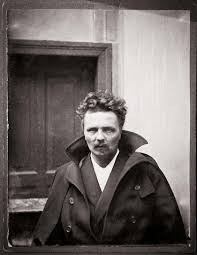NUANCES: Change, madness and the universe
When I recently turned sixty, friends and acquaintances sent me pictures of a young man. When I look at them I wonder who this spirited young man may be, with his waving mane of hair and white teeth. It's definitely not the same balding man with yellowing tusks whose aged face every morning meets me in the bathroom mirror. For years I have believed me to be identical with that smiling youth, despite the fact that he no longer exists. Well, that´s not entirely true, it must be acknowledged that in some sense he is still alive, in accordance with William Faulkner´s well-worn axiom: "The past is not dead, it's not even past."

Ten years after the photo was taken in Santo Domingo the young man was forty years old and lived in New York together with his wife and two beautiful daughters. They lived in a skyscraper with thirty floors, located on the 31st Street, between Lexington and Third as the saying goes in New York.
The apartment was small, but cozy and bright. It was to some extent a jerry-building, the family waged a constant war against tiny cockroaches that despite regular spraying insisted on returning to the kitchen cabinets. The apartment was built with plasterboard and other cheap materials, though the entire edifice gave a luxurious impression. At the entrance there was a garden with a pavilion. The lobby was elegant, or maybe somewhat too flashy, and furnished with a large desk always manned by two uniformed, male receptionists. At an impressive top floor there was a swimming pool and a fitness club.

When we swam in the pool, which was surrounded by panoramic windows, it felt like floating among Manhattan's skyscrapers and when the young man afterwards ran on one of the fitness club´s treadmills he could through the window, that in front of him ran from ceiling to floor, look down deep into the gorges where a never-ending stream of yellow taxi cabs flowed between high-rise buildings which gleaming facades during day reflected the sky with its drifting clouds and during evenings the radiance from thousands of lighted windows, neon lights and passing aircrafts. Often he sat in the sauna and conversed with their neighbors, many of them young stockbrokers who worked further down on Wall Street.

Almost daily he strolled to the Mid-Mahattan Library to work on his thesis in the spacious reading room. There, as in so many other places in New York, he was seized by a feeling of having been there before, this was probably due to all the movies he had seen. The library had for example figured in Ghostbusters and for sure in several other movies and TV series as well. As he sat in the huge reading room writing down his findings in note book after note book he sometimes came to think about what a drunk man once told him in the cafeteria, namely that Melville wrote Moby Dick in the same hall, which on further consideration proved to have been impossible since the great writer had been dead and buried before the library was built. The young man also worked a lot at the Schomburg Library in Harlem, where the buildings were lower, the streets broader and people darker than in Downtown Manhattan.
The family had several good friends within the apartment building and sometimes he was out on the town with an eccentric and short-tempered friend he knew from his time in Guatemala, David Stoll, who wrote a critical and criticized book about Rigoberta Menchú. When David appeared at Windsor Court´s lobby, he was by the receptionists always referred to the commodity entrance at the building's backside, this was because he had the bike with him and was dressed in a rather peculiar sports attire. The young man had to take the elevator down to meet David among the garbage containers and newspaper stacks.
David Stoll arranged for his acquaintance from Guatemala to give a couple of lectures at New York University. Sometimes they went to a pub together and at such occasions it happened that the young man was introduced to some of David's former professors and mentors. Probably David Stoll wanted to help the young man in his academic career, but at that time he did not really understand it.
Among others, he met the white-bearded and bald Michael Harner, a legendary anthropologist who had written wrote a standard work about the Jivaró, the headshrinkers of the Amazon. Already at that time, Harner had turned into shamanistic guru with a group of devoted followers. Nevertheless, the professor gave a tranquil impression and did not seem to be particularly fanatical while listening intently as the young man told him about his studies of Dominican Olivorism. After that animated conversation, he wrote a letter to Harner, but the bearded anthropologist did not respond and the contact was eventually forgotten.

Through David Stoll, he also met with Michael Taussig, whose books fascinated the young man at the time. Taussig taught at Columbia University and was a fresh thinker when it came to art, magic, neurology and cultural criticism. Together they saw Fritz Lang's M in a film club and afterwards they had an intense and unforgettable discussion about the symbols appearing in the movie. He never wrote to Taussig and that was probably rather stupid, they had gotten along well and Taussig could possibly have been a good, academic contact for the future.
More memorable and something that probably was instrumental in shaping the young man's mind and character were probably his monthly meetings with the charming and amiably naive, but also intellectually sharp writer Esther Hautzig. Esther, who was born in Vilna, raised in Siberia and married to a concert pianist, was always friendly and attentive while they drank tea together in a Russian or Jewish café. For several years he corresponded sporadically with Esther until she slowly slipped away into Alzheimer's shadow world.
While in New York the young man wrote an occasional letter to his uncle Otto, but his response was becoming stranger and gradually took on the character of conversations the youngster ten years previously had had with patients at St. Lars mental institution in Lund, Sweden, where he for a time had been moonlighting as a caregiver for severely schizophrenic patients. They could start a conversation in a fairly normal way, only to almost imperceptibly slip into complaints about how demons twisted their intestines while the evil creatures wondered if there "would be any fish today," they caressed imaginary cats which purred while resting on their knees, or the bewildered patients told him how evil communists tried to terminate them by means of electrical energy which was directed towards them from a huge generator carefully hidden away in the hospital's basement.

Panta rei, everything flows, nothing is permanent. The young man has disappeared out of sight, he and his world has been gradually lost. Only dim memories remain, like in a poem by the Swedish Nobel laureate Werner von Heidenstam:
A tremor in a distant space, a memory
of a home, which shone among tall trees.
What was I? Who was I? Why did I weep?
It´s all forgotten now, like a song within a storm
everything rushes away among worlds that roll on.
Not only has his world changed, several friends from back then are not here anymore. Uncle Otto became increasingly confused and in the end he ate the letters instead of answering them. Now he, like Esther Hautzig, is deceased. In New York, there was also Dr. Thomas, my psychotherapist, who I have mentioned in a previous blog post. He is still alive, but is he the same person as the one I once knew?
When I few months ago, mentioned Dr. Thomas in a blog post I searched online to find a picture of him and then found that he had written a few books, including a non-fiction book called The Shame Response to Rejection. I assume that book concerned theories about the damaged and neglected child that Dr. Thomas used to talk about and that he during several years tested his clients within the prison community. I also found another book by Dr. Thomas, Have Faith InThe Good, a title consistent with the impression I had of the doctor as a friendly, insightful man with a long and rich experience gained through his care of violent prisoners. I already knew that Dr. Thomas was religiously interested and he had several times indicated that he had a strong Christian faith. However, the content of his book came as a complete surprise.
It is a confusing piece of work. It was undoubtedly written by the same Dr. Thomas I had known, the life story of the two doctors, the one I knew and the one who wrote the book, is at least identical. Perhaps was the aging Dr. Thomas like Esther Hautzig and Uncle Otto entering into Cuckooland, which is what many Americans call senility´s shadow world? Maybe did he as they saying goes in my childhood´s Göinge: "not have all his chickens at home"? What sparked my doubts about the good doctor's mental balance was maybe just the fact that I had expected something completely different than what he wrote in his book. Maybe I wanted to be confronted with a deepening of the themes Dr. Thomas used to talk with me about, namely, how people's fears made them uncertain about how precious it is to do good, while expressing love and kindness. How important it is to seek and find the good in ourselves and in others and not lapse into anger and violence -Have Faith in the Good. Dr. Thomas had apparently pursued the good, not only among his paying patients and people who lived a similar life as he, but also among criminal offenders.
The thirty years old man who can be seen at the beginning of this blog entry has changed. Perhaps beyond recognition. Would it be so astonishing the Dr. Thomas of today was different as well?
Were there similarities between him and me? Correspondences? I had once written a university dissertation about Emanuel Swedenborg, the incredibly productive Swedish eighteenth-century mystic who founded a church and influenced several admirable writers like Blake, Balzac, Baudelaire and Strindberg, primarily through his remarkable correspondence doctrine based on the idea that everything in our earthly existence reflects what exists and takes place in a different, "spiritual" world. According to Swedenborg, there is an ever ongoing interaction between these two forms of existence, a "correspondence". Dr. Thomas writes:
There is only a thin sheet that separates Heaven and Earth. In Jerusalem nothing separates Heaven and Earth. Certain individuals traditionally known as angels and messengers pass back and forth between the two realities seemingly without hindrance. […] Is there a fifth dimension where times as we know it does not exist? I believe so.

A view that in my opinion is somewhat distanced from normality. Correspondences? Do they really exist? Perhaps they are nothing else than quite insignificant incidents that our preprogrammed views of reality pick out of their proper context and convey a far deeper meaning to than they actually have. Apparently life is filled with such “correspondences”, my own life experience presents quite a number of examples. Even in connection with Dr. Thomas´ book. The Introduction is written by a certain Michael Hogan, a person I have actually met, not in New York but in Guadalajara, Mexico. I remembered his name since Anastasia Clafferty, a friend and colleague of mine working at FAO in Rome, once lent me a book by him. Anastasia is a proud, Irish patriot and assumed I would be interested in reading Michael Hogan's The Irish Soldiers of Mexico, which deals with a contingent of Irish soldiers that during the US-Mexican War 1846-48 deserted from the US army to join the Mexicans in their struggle against the northern invaders.
When I read the Hogans´s book I remembered how I several years before during a reception at the University of Guadalajara had met the author in person. I do not remember much more about him than his name and had no idea about his connection to Dr. Thomas. It was Atilio Boron, who introduced him to me and Berit Olsson, my boss at Swedish International Development Cooperation Agency. Atilio was heading CLACSO, a pan-American research institute funded by Sida and he was like Michael Hogan a big fan of Noam Chomsky. If I remember correctly, Hogan had something to do with the university, though at the time I met him he worked at the American School in Guadalajara.
Remembering Guadalajara makes me think of another rather strange coincidence. When Berit and I went to meet with the Rector of the University of Guadalajara we stepped out of a taxi by the entrance to the university's impressive main building, where the headmaster and his wife awaited us at the top of the stairs. When we were half-way up the rector´s wife exclaimed in Swedish:
- But Jan, you are here!
Berit looked at me wide-eyed and I was just as surprised as she was, especially when it turned out that the exuberant lady, who I did not recall meeting before, remembered me very well. She was a Chilean lady and had previously been married to the owner of Ove´s Pizzeria in Lund, the place´s name was actually O'Vesuvio and it had in 1971 opened as one of Sweden's first pizzerias (at that time it was also a piano bar). I have unfortunately forgotten the lady´s name, but she was a good friend of Alicia, one of our best friends in Lund and like Alicia, she had worked as a nurse at the hospital. The last time I met the lady in question was a decade earlier when I helped Alicia and Miguel to move from one part of Lund to another. Since then she had divorced Ove's owner, traveled back to Chile, but at her arrival there applied for a job as secretary at the University of Guadalajara, where the rector had fallen in love with her, they married and had several children together.

Well then, besides being an historian Michael Hogan was also a poet and had met with Dr. Thomas when he had been invited to a writers' workshop at Pittsburgh's Central Prison, where Dr. Thomas was resident psychiatrist. The occasion for the invitation was the first prisoner-organized program of its kind and it was initiated by Dr. Thomas and a certain John Paul Minarik, a poet imprisoned for life after having been found guilty of murdering his girlfriend with an axe in 1971. What I could find out about Minarik suggests that he is still locked up in Pittsburgh.
Dr Thomas writes:
I believe that my work as a psychiatrist in caring for countless men in maximum prisons, first in Michigan and then in Pennsylvania, has been the most important fact of my life. Many of them I still remember, and many events that occurred in those years are still very clear in my mind. Training in psychoanalysis helped me to better understand them and how we related to one another as significant others.

While reading those lines I imagined that Dr. Thomas was going to write about his involvement with life-sentenced prisoners, instead he described random encounters with mostly beggars and homeless individuals, odd people who he believes serve as messenger from a higher reality. Like the great Swedish author August Strindberg during his so called “inferno crisis” Dr. Thomas appears to have ended up in a world where the tiniest, trivial detail is interpreted as if it contained a most profound spiritual truth, entirely in accordance with Swedenborg's correspondence teaching. Through my conversations with Dr. Thomas, I know he had read Swedenborg. At one point, I mentioned the Swedish prophet and Dr. Thomas who did not know about him immediately wrote down his name and apparently later read a lot about and by Swedenborg. However, in his strange, little book Dr. Thomas does not mention the Swedish mystic, but a certain Leonard Susskind, a theoretical physicist who writes about things I do not understand.
Susskind´s research deals with cosmic holography which means that the universe can be described as a giant hologram, quite different from the reality most of us believe we inhabit. A place where neither time nor place exist, where each part contains the entirety and each cell of a multicellular organism contains sufficient information to build up a complete body. Each cell can thus be said to contain the whole cosmos; galaxies rest latent in one of our hairs. Everything is inter-connected, the world does not consist of individual particles, but of vibrating strings.

In a poem, the Hungarian poet Sandor Weöres coupled Emanuel Swedenborg´s philosophy with this complex universe, how the immensely large is matched by the smallest fractions and the fact that Swedenborg considers love to be the force that provides life to everything:
Swedenborg in Memoriam
By the original source we examine our love
and only the silent space provides the answer
so clear, that the vessel of huge words
cannot catch what fills up the tiniest word.
Dr. Thomas seems to be well at ease in this strangest of worlds. For him, our everyday reality does not seem to be particularly significant, other than as an indication of a wider dimension. When he writes about his last day at the State Correctional Institution of Pittsburgh where several death row inmates are locked up, he does not describe his final meeting with a prisoner convicted to lifetime imprisonment, instead he tells about how, after he had left the cell of the convicted man, flocks of sparrows appeared as he walked along the top tier of the huge prison complex. He interprets the sparrows´ flight as some kind of divine message directed to him:
I retraced my steps along the catwalk which meant walking almost the full length of the block. As I did so flight after flight of noisy sparrows would swoop up beside me and then dive back down. This was repeated five or six times as I walked along. As a parting salute, it was something I could never have imagined. This occurred in 1992. My growing awareness of another reality is what I want to share with the reader.

According to Dr. Thomas - how does this "increased awareness" manifest itself? Dr. Thomas places the great cutoff point from his earlier existence to 2001, when he was seventy-three years old and along with his wife, to celebrate their fifty years together, from their children received a trip to Italy. Outside the cathedral of Orvieto, Dr. Thomas found himself standing mesmerized in front of a representation of devils who with tridents pushed condemned souls into the hell fire. Suddenly he realized that these devils "were well known and had been so either forever or for a very long time. They are to be taken seriously”. Dr. Thomas cannot explain why the idea struck him with such a violent force, but already back then he understood that something ominous soon would happen and after returning to the US he renewed his Canadian passport and transferred the family savings into an account in Canada.

On September 11 the same year, he eats an early breakfast on Manhattan when he is unexpectedly affected by a strong feeling of anxiety. Worried he calls his assistant and cancels all psychoanalyses sessions scheduled for the day. Bewildered he comes out into the street, where he overhears people talking about a plane hitting the World Trade Center. At first, Dr. Thomas assumes it is an accident similar to the one in 1945 when a plane crashed into the Empire State Building. A tune callled Wales Forever popped up in his head and made him enter a delicatessen to buy two bottles of Welsh Tynant Springwater. He continues walking down along Madison Avenue to visit his daughter and give her the bottles. When he enters the street after visiting his daughter he finds that the blue sky is quickly becoming darkened by a big dust cloud. He understands that a disaster has taken place. When Dr. Thomas realizes that the twin towers have collapsed, he wonders about his strange whim of buying two bottles of Welsh spring water. It must have been a sign from above! Something connected with the fall of the Twin Towers. After intense speculations he remembers that his mother's great-grandfather came from Wales, just as his father's great-grandfather, the two men were actually brothers. Based on this quite illogical chain of proofs Dr. Thomas became convinced that there was a connection between himself and the fallen Twin Towers. He realized that for anyone who is able to discern it everything is connected and this fact has something to do with an eternal connection between this world and "the other realm".
According to Dr. Thomas are people all over the world searching for sites where they can connect with a spiritual dimension. He found such a presence in Orvieto and assumed that other spiritual seekers accede to holy like Mecca, Rome, or Benares, in search of a tangible presence of the divine. Dr. Thomas is a Christian and thus assumes that for him Jerusalem must be the place where he can most easily get in touch with the spiritual realm.
After his experience in New York Dr. Thomas travels every three months to Jerusalem, where he has begun a routine meaning that he at four o'clock every morning walks down to a high palm tree that he believes is growing in the place where Jesus was crucified. He has with him a plastic bag and clear up the site from trash and debris, something that takes him about two hours, then he sits on a bench and meditates and it is at such moments that people who he believes to be "messengers" or "angels" appear.

One morning when he sits deep in thought he feels a peculiar presence close by. When he lifts his head Dr. Thomas finds that just in front of him stands a young, well-dressed and exceptionally fresh looking young man. Despite his quiet and tidy exterior the man makes Dr. Thomas feel extremely uncomfortable. Quite unexpectedly, the man asks him: "What is really this thing about Jesus Christ?" Without answering Dr. Thomas points towards the tall palm tree and the unknown man proposes that both of them may go over there. After silently having watched the tree the two men sit down on a bench. The young man is carefully shaven, smells of aftershave and is dressed in what looks like a black Sandhurst military uniform, but without any buttons or insignia. He utters nothing else than his question about Jesus, but Dr. Thomas wrote: "I have never met a more pleasant person."

On another occasion, the doctor finds himself by the palm tree and is suddenly and violently attacked by a pack of black dogs, which, however, after some growling runs off without hurting him. A man turns up, supported by a cane and produces from the thin air a book which he places on the cane. Dr. Thomas glimpses the words "temple" and "Messiah." The man asks him whether he knows who the Messiah was and when Dr. Thomas replies "Jesus Christ," the man went away without another word. Another day, Dr. Thomas is bringing flowers to Virgin Mary's tomb and on his way he passes a black dressed, elderly lady with a face so radiant that he strats shaking inside, she smiles at him. A few days later he once again catches a glimpse of the beautiful woman, this time she sits side by side with a much younger lady, also dressed in black, who leans her head against the older woman's shoulder. Both smile at him. Dr. Thomas cannot discern if they are sitting on something, it seems as if they are floating in the air.
One morning, Dr. Thomas cellphone sounds, when he lights it up he discovers that the call is not addressed to him. He listens to someone telling another person that due to his bad health he must rest for two, entire years. This convinces Dr. Thomas that for two years he must renounce his habit to travel to Jerusalem. It turns out to be a wise decision because it enables him to settle his affairs in the United States and Canada, resulting in him becoming completely debt free and financially independent. While Dr. Thomas finds himself in New York, he continues to meet people who he believes to be messengers from a spiritual realm, mostly homeless beggars.
To me the meetings Dr. Thomas describes so carefully seems to be fairly random and insignificant, but to him they appear as very important. I do not understand why Dr. Thomas talks about all these pointless meetings, while he refrains from mentioning things that I would consider to be much more interesting, such as his work as a psychiatrist working with condemned murderers and thugs, or even things that we used to talk about - children's problems, common feelings of shame and shortcomings, people's propensity for violence, the inherent love that many of us stifle and have difficulties in expressing. No, page after page he devotes to detailed descriptions of everyday encounters and events that to him confer a great, highly personal significance, but leaves the reader baffled. Everything told in Dr. Thomas simple, quiet authoritarian and extremely friendly manner, even if the language often conveys an unpolished and even rather clumsily impression.
Reading Dr. Thomas oddities makes me think of the letters I received from Uncle Otto while I lived in New York. Letters written while he was heading straight into Alzheimer's confusing world. He writes extensively about how he every morning walks down to the sea shore to buy fish, quotes what the vendors say, tells me how much he pays, what kind of fish it was he bought and how the vendor carefully wraps it and places it in a brown paper bag. As if every action, every word carried a hidden meaning. Uncle Otto writes about birds and trees he watches along his way home to Roslins Väg 14B, without any particular concerns why he tells me all that. They are all oddly accurate descriptions, but they are also slightly creepy since I cannot understand why Uncle Otto's provided me with such meticulous accounts. I now assume they hint at a deeper meaning. Was it the fear of sliding into the mental darkness that threatened him that made him write to me, a nephew far away in distant New York and in such detail describe what was happening to him? Did he try to explain that he still had a certain grip on reality? And all this fish he bought, what is because it is commonly believed that fish is good for the brain?

What drove Dr. Thomas to write his remarkable book? I asked a colleague of mine who recently had been travelling around in the US. How did she interpret the fact that a reputable, professional psychiatrist that I had known and admired suddenly wrote weird books about his encounters with heavenly messengers. She replied that it probably was because he, like so many other Americans, was deeply religious and therefore did not consider it to be especially strange to describe and confess his somewhat remarkable faith to others.
I am thinking about why I was intrigued by Dr. Thomas oddities. Are perhaps correspondences governing my own life? In the Dominican Republic, I made during my research into the history of religion in the San Juan Valley acquaintance with a more than a century-old man who, like Dr. Thomas, claimed that "here are two worlds in one", one was the spirit world, while the other one was what I called “reality”. God, dreams, the dead, music and demons inhabit the “spirit world”, but people like me does not understand that and thus do not have any contact with it, while people like Julian Ramos knew the spiritual world quite well and were like him able to walk from one world to another as someone "walking through sun and shade."
While I lived in Paris I read Strindberg's strange Inferno, a book in which he, one again like Dr. Thomas, discovers how the spiritual world constantly breaks into his life with signs and warnings. I found that Strindberg had these experiences while he walked through the streets I used to walk along and just as I often did he ended up within the Montparnasse Cemetery, the Luxembourg Gardens or in the Botanical Gardens. I also discovered that his most terrifying encounter with the "spirits", where "wrestled with the Invisible" and the place where he imagined himself to be attacked by enemies equipped with mysterious devil machines, occurred in a hotel at a street just a hundred yards from my home - Rue de la Clef, The Street of the Key.

Perhaps you may detect "correspondences" wherever you are. An inner state creates external sights and events. A sensitive man, or woman, may be able to make an unconscious choice among thousands of other possibilities – they choosing their own chance, their own destiny. The possibility exists, of course, that men like Swedenborg, Strindberg, Julian Ramos and Dr. Thomas were all more or less mad. However, it may also be that the entire universe is composed of incomprehensible "correspondences" meaning that we all are integral parts of a powerful connections. Something that only the most sensitive among us can perceive. Where time and space do not exist, where I am identical to the young man I once was and he is identical with me. Where madness turns into an aspect of rationality, where - with the words of the Swedish poets Gunnar Ekelöf: "everything is in everything, at once its end and its beginning" and you can feel that "here and now is both our departure and homecoming."
Hogan, Michael (1998), Irish Soldiers of Mexico. Guadalajara: Fondo Editorial Universitario. Susskind, Leonard (2005), The Cosmic Landscape: String Theory and the Illusion of Intelligent Design. New York: Little, Brown and Company. Thomas, Herbert E. (2011), Have Faith In The Good. New York: VBW Publishing. I could not find any English translations of the quoted poems of Sándor Weöres, Werner von Heidenstam and Gunnar Ekelöf and unfortunately had to do them myself, of course I translated Weöres from Swedish, not from Hungarian.






